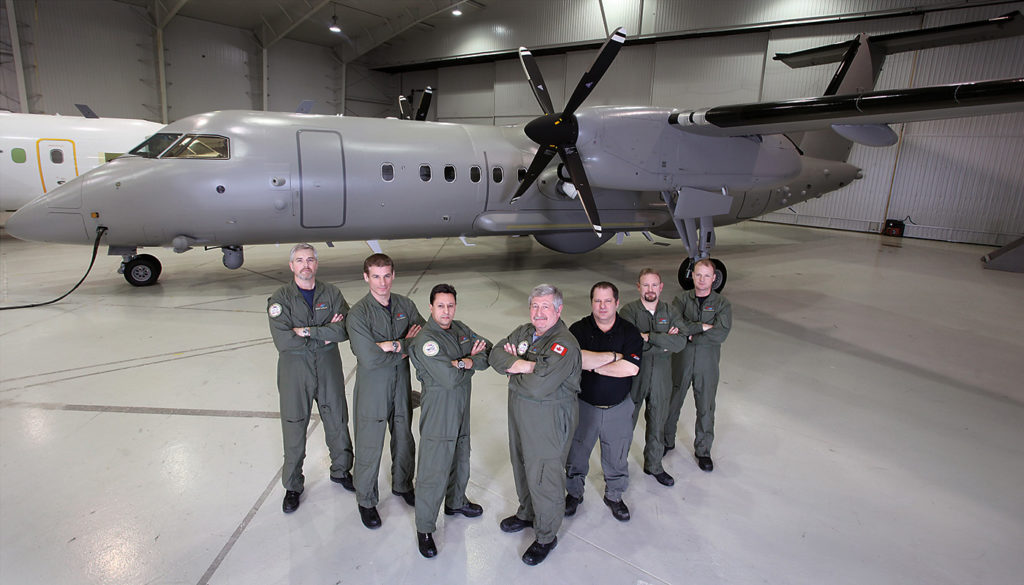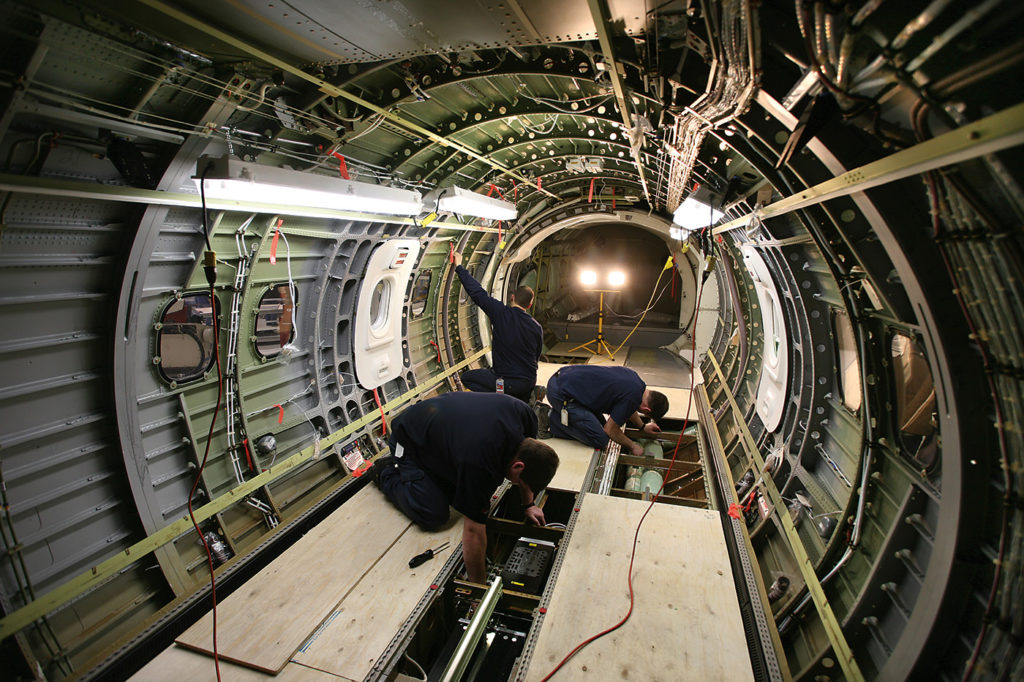Estimated reading time 7 minutes, 28 seconds.
If you need intelligence, surveillance and reconnaissance (ISR) information on short notice or for a limited duration, who do you call?
Contracted airborne ISR services are nothing new–coast guard, fisheries and search and rescue departments and agencies have long used private aircraft to augment government fleets. But such services usually involve longer-term arrangements of several years.
What if you only require data by the hour?

Enter the Force Multiplier, a Bombardier Dash-8 Q300 modified with state-of-the-art sensors, mission management suites and data transmission capabilities, available, with a full crew, by the hour, the day, or the month.
PAL Aerospace is banking on a simple concept: everyone needs more ISR.
Whether it’s search and rescue (SAR), monitoring fishing boats and other coastal traffic, detecting maritime pollution, patrolling border crossings, interdicting drug and human trafficking, providing disaster relief, or even assisting military missions, the demand for actionable intelligence derived from ISR data has grown exponentially in recent years.
The St. John’s, N.L.-based company has been providing contracted air services to Canadian governments for the past 31 years, primarily for the federal departments of Fisheries and Oceans and National Defence and with provincial medevac services. Over the past decade, it has expanded to the United Arab Emirates and to counter-narcotics, SAR and coast guard operations in the Caribbean with Curaçao and Trinidad & Tobago. It has also serviced and modified aircraft for customers around the world.
And with each job has come a common refrain.
“Many of our customers whom we work with have asked us, ‘Do you have something in the interim? Do you have something that’s available for the next three months? For one month of the year? Something that could help us do training?’ ” said Michael Sangster, PAL’s chief commercial officer. “With the Force Multiplier, we’ll be able to provide the solution they need.”

The grey-painted Dash-8 Q300, which will be unveiled at the Dubai Airshow in November and available to customers in 2018, is fitted with some of the most advanced ISR systems available, including Thales’ multimode AESA Searchmaster radar, L3 Wescam’s MX-15 high definition imaging electro-optical/infrared camera, Saab’s marine automatic identification tracking and interrogation system, Rockwell Collins’ airborne direction finding system, Inmarsat’s broadband and beyond-line-of-sight SATCOM connectivity, and two mission suites–Thales’ modular AMASCOS management system and CarteNav Solutions’ AIMS-ISR mission software, connected to a dedicated ground station.
Impressive as the technology is, to Sangster the systems are merely a means of gathering, processing and moving data in standard formats as a customer requires.
“You can talk about the technology, but it is really a data collection tool,” he said, echoing the words of Gen Rick Hillier, former chief of the defence staff and a corporate counsellor to PAL, who advised that commanders just want to know what is happening, not how the data is delivered.
“We’re a data company and we believe we can get all the information needed down to our clients in real time, to anywhere in the world, to allow an operation to succeed,” said Sangster.
Mission systems operators could be provided entirely by PAL or as part of a PAL-client team. “We’ll give commanders on the ground the situational awareness they need to operate effectively, no matter the mission.”
PAL has yet to announce initial customers for the service, but believes there is significant interest from a wide range of customers in Canada and internationally.
In fact, the company believes the concept could offer a competitive niche. For government agencies or militaries weighing the costs of an ISR or special mission aircraft fleet, the Force Multiplier could provide a short-term showcase for risk-averse leaders to understand and appreciate the capability. It could fulfil immediate requirements when a cumbersome procurement process would take too long. It could also surge or augment existing ISR capabilities for events like international leaders’ summits or sporting events like the Olympics or FIFA World Cup.

Pixel-by-the-hour may also be an ideal solution for clients with periodic ISR needs who don’t want the added costs of operating, supporting and maintaining aircraft.
“We’ll operate and maintain the aircraft, so they’ll have no programmatic risk and no capital outlay. That’s pretty enticing to a lot of clients,” said Sangster. “Based on our experience and our partners, Thales and CarteNav, we think there are many different customers who need this service today.”
That could include serving as a training platform for clients that don’t have available aircraft but who want to maintain or develop their aircrews.
Duart Townsend, a former Royal Canadian Air Force (RCAF) helicopter pilot and PAL’s director of business development, said in addition to providing training, the company can evaluate client flying standards and currency requirements to ensure training would meet operational needs.
Though the market is still being defined, the long-term vision is for a mixed fleet of fixed- and rotary-wing aircraft on call for specialized missions around the world. That would mean having dedicated aircrews on standby, but Sangster insisted that, with operations in Canada, the UAE, Trinidad and Curaçao, PAL has the resources to draw on.
“With our success in the fixed-wing search and rescue program (PAL is responsible for in-service support of the Airbus C295W), there is a long list of people who want to come work for PAL,” he said. “We know we have the resources to run this program. We are also used to surging capacity for our clients, and the PAL ethos and culture is all about being customer-focused. We will ensure that support issues never get in the way of delivery.”
Sangster would not disclose rates for short-term ISR rental–each mission could have unique requirements and costs. But he was confident the aircraft would be cost-competitive and below the price associated with acquiring and operating a larger fleet.

“We’re not publishing a number, but we have a very good idea of what it is based on different scenarios,” he said. “There is no capital outlay for a client, there is no traditional procurement process to slow you down, and clients can save significant amounts of money while receiving the services they need.”
With the burgeoning global requirement for multi-mission aircraft, either to replace aging Lockheed Martin P-3 Orion and similar surveillance aircraft or to introduce the capability into countries with increased maritime domain awareness needs, PAL may be well positioned with the Force Multiplier to provide a concept validation platform on a short-term basis. The aircraft could also open the door for full-service solutions to new clients in South America, Europe, Asia and Africa.
“But we think it is a business on its own that will operate around the world,” said Sangster. “These aircraft will be busy.”
The Force Multiplier might also fill a gap in the RCAF’s expanding surveillance requirements. At an address to the Canadian defence industry in April, commander LGen Mike Hood challenged companies to deliver the leading anti-submarine warfare and ISR capabilities of the CP-140 Aurora on a future Canadian-built airframe.
“Let’s experiment together and find innovative technologies, ways of thinking, and approaches to advanced air power,” he urged.
Sangster said the aircraft could be the solution when other aircraft are deployed elsewhere or down for maintenance.
“I think it is our responsibility to help the Air Force,” he said. “We think we can help fulfil military requirements around the world and we are excited to get on with the job.”


Nice advances and developments per say, that’s great in other way because they using the fabulous Dash-8. That bird is literally a real tank and for jobs done department, that one never let you down and this even taxiing in 2 feet of snow.
This is a very interesting business concept. Can’t wait to see the final surveillance aircraft. Gotta love Dash-8s!
Thank you for the great post
Thank you!